Small overlap front
The small overlap front evaluation consists of a driver-side and a passenger-side component. If the results of the two evaluations differ, then the combined small overlap rating is equal to the lower rating.
Driver-side
- Rating applies to 2020-25 models
Tested vehicle: 2017 GMC Acadia SLT1 4-door 4wd
The GMC Acadia was redesigned for the 2017 model year. It is smaller and lighter than the earlier design and therefore is now classified as a midsize SUV.
The earlier design remained in production for only the 2017 model year, available new only to fleet buyers, and was called the GMC Acadia Limited. The ratings on this page do not apply to the Acadia Limited.
These ratings also apply to the Cadillac XT6, a midsize luxury SUV introduced in the 2020 model year.
| Evaluation criteria | Rating |
|---|---|
| Overall driver-side evaluation | |
| Structure and safety cage | |
| Driver injury measures | |
| Head/neck | |
| Chest | |
| Hip/thigh | |
| Lower leg/foot | |
| Driver restraints and dummy kinematics | |
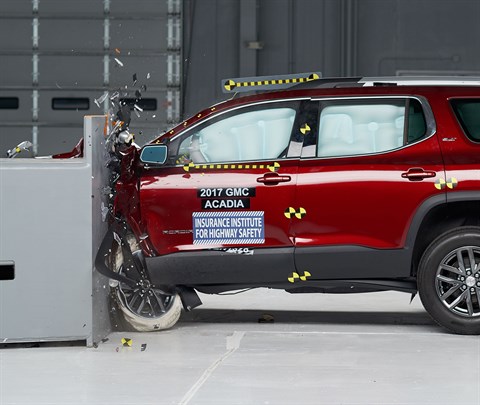
Action shot taken during the driver-side small overlap frontal crash test.

The dummy's position in relation to the door frame, steering wheel, and instrument panel after the crash test indicates that the driver's survival space was maintained very well.

The frontal and side curtain airbags worked well together to keep the head from coming close to any stiff structure or outside objects that could cause injury.
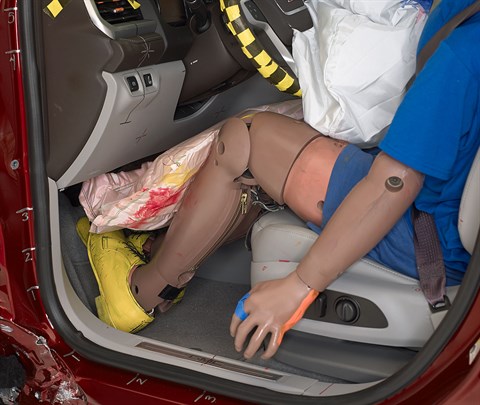
The driver's space was maintained well, and risk of injuries to the dummy's legs and feet was low.
Passenger-side
- Rating applies to 2020-25 models built after October 2019
Tested vehicle: 2020 Cadillac XT6 Platinum Premium Luxury 4-door 4wd
The Cadillac XT6 was introduced in the 2020 model year. This midsize luxury SUV is built on the same platform as the GMC Acadia. Beginning with 2020 models built after August 2019, the passenger-side front door hinge pillar and A-pillar were reinforced to improve occupant protection in passenger-side small overlap frontal crashes. Beginning with 2020 models built after October 2019, changes to the side curtain airbags were implemented to further improve occupant protection.
Passenger-side small overlap frontal ratings are assigned by the Institute based on a test conducted by General Motors.
| Evaluation criteria | Rating |
|---|---|
| Overall passenger-side evaluation | |
| Structure and safety cage | |
| Passenger injury measures | |
| Head/neck | |
| Chest | |
| Hip/thigh | |
| Lower leg/foot | |
| Passenger restraints and dummy kinematics | |
| Driver injury measures | |
| Head/neck | |
| Chest | |
| Hip/thigh | |
| Lower leg/foot | |
| Driver restraints and dummy kinematics | |
Moderate overlap front: original test
Rating applies to 2020-25 models
Tested vehicle: 2017 GMC Acadia All Terrain 4-door 4wd
The GMC Acadia was redesigned for the 2017 model year. It is smaller and lighter than the earlier design and therefore is now classified as a midsize SUV.
The earlier design remained in production for only the 2017 model year, available new only to fleet buyers, and was called the GMC Acadia Limited. The ratings on this page do not apply to the Acadia Limited.
Moderate overlap frontal ratings are assigned by the Institute based on a test conducted by General Motors on an Acadia. These ratings also apply to the Cadillac XT6, a midsize luxury SUV introduced in the 2020 model year.
| Evaluation criteria | Rating |
|---|---|
| Overall evaluation | |
| Structure and safety cage | |
| Driver injury measures | |
| Head/neck | |
| Chest | |
| Leg/foot, left | |
| Leg/foot, right | |
| Driver restraints and dummy kinematics | |
Moderate overlap front: updated test
Rating applies to 2023-25 models
Tested vehicle: 2023 Cadillac XT6 Sport 4-door 4wd
The Cadillac XT6 was introduced in the 2020 model year. These ratings do not apply to the GMC Acadia.
| Evaluation criteria | Rating |
|---|---|
| Overall evaluation | |
| Structure and safety cage | |
| Driver injury measures | |
| Head/neck | |
| Chest | |
| Thigh/hip | |
| Leg/foot | |
| Driver restraints and dummy kinematics | |
| Rear passenger injury measures | |
| Head/neck | |
| Chest | |
| Thigh | |
|
Rear passenger restraints and dummy kinematics
| |
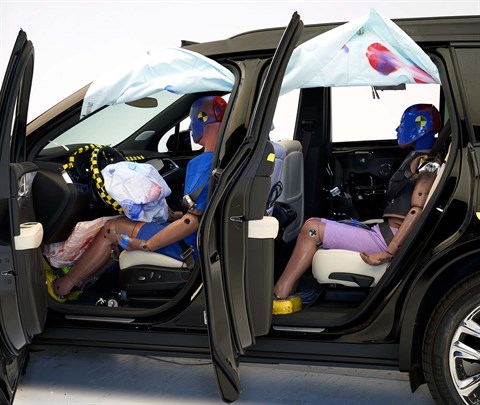
View of the vehicle after the crash showing the airbags and damage to the occupant compartment.
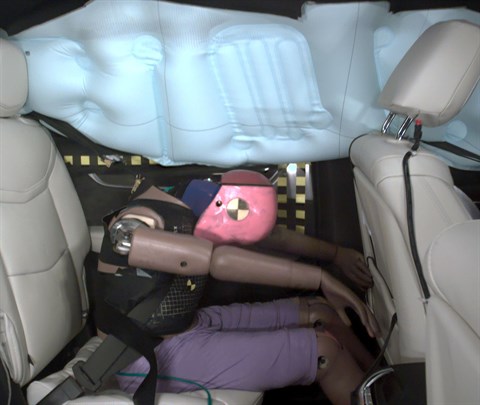
The rear passenger dummy's head remained a safe distance from the front seatback.
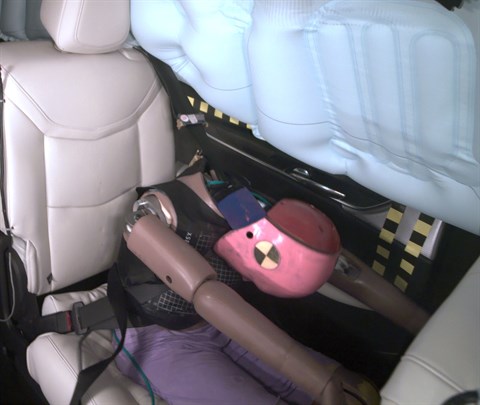
Rear passenger dummy injury values indicate a moderate risk of injury to the head or neck and a likely risk of injury to the chest. During the crash, the shoulder belt remained in an ideal position on the dummy’s chest.
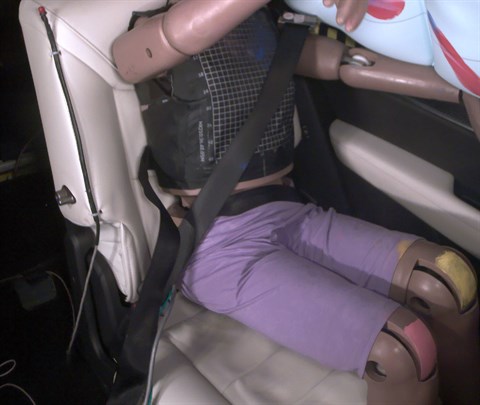
The rear passenger dummy's lap belt moved from the ideal position on the pelvis onto the abdomen, increasing the risk of abdominal injuries.
Side: original test
Rating applies to 2020-25 models
Tested vehicle: 2017 GMC Acadia All Terrain 4-door 4wd
The GMC Acadia was redesigned for the 2017 model year. It is smaller and lighter than the earlier design and therefore is now classified as a midsize SUV.
The earlier design remained in production for only the 2017 model year, available new only to fleet buyers, and was called the GMC Acadia Limited. The ratings on this page do not apply to the Acadia Limited.
Side ratings are assigned by the Institute based on a test conducted by General Motors on an Acadia. These ratings also apply to the Cadillac XT6, a midsize luxury SUV introduced in the 2020 model year.
| Evaluation criteria | Rating |
|---|---|
| Overall evaluation | |
| Structure and safety cage | |
| Driver injury measures | |
| Head/neck | |
| Torso | |
| Pelvis/leg | |
| Driver head protection | |
| Rear passenger injury measures | |
| Head/neck | |
| Torso | |
| Pelvis/leg | |
| Rear passenger head protection | |
Side: updated test
Rating applies to 2020-25 models
Tested vehicle: 2023 Cadillac XT6 Luxury 4-door 4wd
The Cadillac XT6 was introduced in the 2020 model year and the GMC Acadia was redesigned for the 2017 model year.
| Evaluation criteria | Rating |
|---|---|
| Overall evaluation | |
| Structure and safety cage | |
| Driver injury measures | |
| Head/neck | |
| Torso | |
| Pelvis | |
| Driver head protection | |
| Rear passenger injury measures | |
| Head/neck | |
| Torso | |
| Pelvis | |
| Rear passenger head protection | |

View of the vehicle just after the crash test.
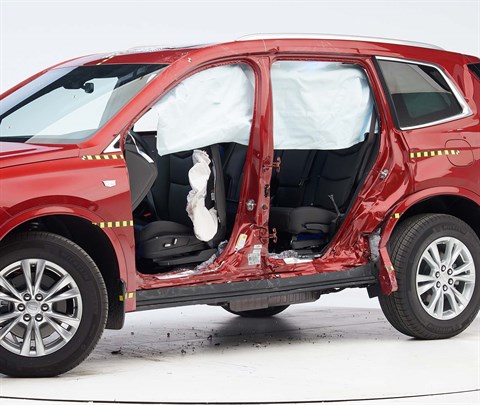
View of the vehicle after the crash with doors removed, showing the side airbags and damage to the occupant compartment.

Smeared greasepaint shows where the driver dummy's head was protected from being hit by hard structures by the side airbags.
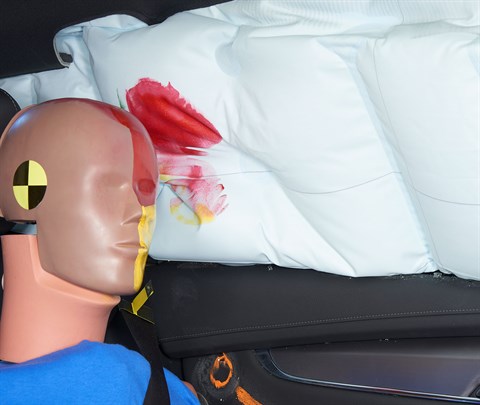
Smeared greasepaint shows where the rear passenger dummy’s head was protected by the side airbag.
Headlights
Ratings are given for 2 different headlight variations available on this vehicle.
Trim level(s)
- Sport trim equipped with Platinum and Premium Headlamp System packages
- Premium Luxury trim equipped with Platinum and Premium Headlamp System packages
| Evaluation criteria | Rating |
|---|---|
| Low-beam headlight type | LED projector |
| High-beam headlight type | LED projector |
| Curve-adaptive? | No |
| High-beam assist? | Yes |
|
Overall rating | |
| Distance at which headlights provide at least 5 lux illumination: | |
Low beams
On the straightaway, visibility was good on both sides of the road. On curves, visibility was good in all 4 tests.
The low beams created some glare.
High beams
On the straightaway, visibility was good on the right side of the road and fair on the left side. On curves, visibility was good in all 4 tests.
High-beam assist compensates for some limitations of this vehicle's low beams on the straightaway, on both left curves and on the gradual right curve.
Trim level(s)
- Sport trim
- Premium Luxury trim
- Luxury trim
| Evaluation criteria | Rating |
|---|---|
| Low-beam headlight type | LED projector |
| High-beam headlight type | LED projector |
| Curve-adaptive? | No |
| High-beam assist? | Yes |
|
Overall rating | |
| Distance at which headlights provide at least 5 lux illumination: | |
Low beams
On the straightaway, visibility was good on both sides of the road. On curves, visibility was good on both right curves and fair on both left curves.
The low beams created some glare.
High beams
On the straightaway, visibility was fair on the left side of the road and inadequate on the right side. On curves, visibility was fair in all 4 tests.
High-beam assist compensates for some limitations of this vehicle's low beams on the straightaway, on both left curves and on both right curves.
Front crash prevention: pedestrian
Seat belt reminders
Rating applies to 2023-25 models
| Evaluation criteria | Rating |
|---|---|
| Overall evaluation | |
| Front row | |
| Unbelted occupant alert (audible & visual) | |
| Initiation time | |
| Duration | Long enough (90+ seconds) |
| Volume | |
| Audio frequency | |
| Second row | |
| Startup status alert (visual) | None |
Child seat anchors
Rating applies to 2020-25 models
| Evaluation criteria | Rating |
|---|---|
| Overall evaluation | |
| Vehicle trim | Premium Luxury |
| Seat type | leather |
This vehicle has 2 rear seating positions with complete child seat attachment (LATCH) hardware.
It has 3 additional seating positions with a tether anchor only.
| Evaluation criteria | Rating |
|---|---|
| Overall evaluation | |
| Vehicle trim | Premium Luxury |
| Seat type | leather |
| Rating icon | Rating |
|---|---|
| G | Good |
| A | Acceptable |
| M | Marginal |
| P | Poor |
| Seating positions that rely on borrowed lower anchors or have only a tether anchor available are not rated. | |
thether anchor symbol | Tether anchor |
lower anchor symbol | Lower anchors |
| Lower anchor(s) can be borrowed from adjacent positions(s) | |
| No hardware available |
Details by seating position
| Position | Rating |
|---|---|
| 1 | |
| Tether anchor | |
| easy-to-find location | |
| no other hardware could be confused for anchor | |
| Lower anchors | |
| too deep in seat | |
| not too much force needed to attach | |
| easy to maneuver around anchors | |
| 2 | |
| Tether anchor | |
| easy-to-find location | |
| no other hardware could be confused for anchor | |
| Lower anchors | |
| none available | |
| 3 | |
| Tether anchor | |
| easy-to-find location | |
| no other hardware could be confused for anchor | |
| Lower anchors | |
| too deep in seat | |
| not too much force needed to attach | |
| easy to maneuver around anchors | |
| 4 | |
| Tether anchor | |
| easy-to-find location | |
| other hardware could be confused for anchor | |
| Lower anchors | |
| none available | |
| 6 | |
| Tether anchor | |
| easy-to-find location | |
| other hardware could be confused for anchor | |
| Lower anchors | |
| none available |
